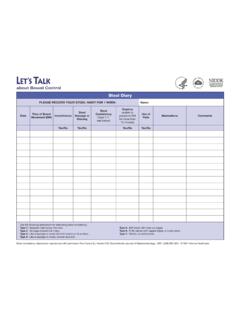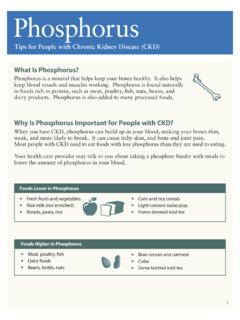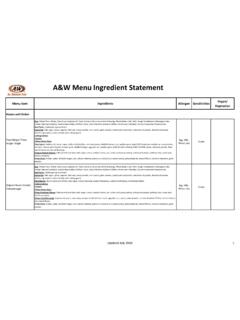Transcription of Tips for People with Chronic Kidney Disease (CKD)
1 Potassium Tips for People with Chronic Kidney Disease (CKD). What Is Potassium? Potassium is a mineral that helps your nerves and muscles work the right way. Why Is Potassium Important for People with CKD? In some People with CKD, the kidneys may not remove extra potassium from the blood. Some medicines also can raise your potassium level. Your food choices can help you lower your potassium level. How Do I Know My Potassium Is High? People often do not feel any different when their potassium is high. Your health care provider will check the level of potassium in your blood and the medicines you take. The level of potassium in your blood should be between to *. How Do I Lower Potassium in My Diet? at smaller portions of foods high in protein at meals and for snacks: meat, poultry, E. fish, beans, dairy, and nuts. se spices and herbs in cooking and at the table.
2 Salt substitutes often contain U. potassium and should not be used. Potassium chloride can be used in place of salt in some packaged foods, like canned soups and tomato products. Limit foods with potassium chloride on the ingredient list. Drain canned fruits and vegetables before eating. you have diabetes, choose apple, grape, or cranberry juice when your blood sugar If goes down. Eat These Foods Instead of These Foods White rice Brown and wild rice White bread and pasta Whole wheat bread and pasta Cooked rice and wheat cereals Bran cereals Rice milk (not enriched) Cow's milk *Normal ranges may vary. ) 1. Potassium How Do I Lower Potassium in My Diet? (continued). Choose fruits and vegetables that are lower in potassium. Have very small portions of foods that are higher in potassium, like one slice of tomato on a sandwich, a few slices of banana on cereal, or half of an orange.
3 Fruits and Vegetables Lower in Potassium (200 mg or less*). FRUITS. Apples/apple juice/applesauce Pears Apricots (canned)/apricot nectar Peaches Berries Plums Cranberry juice Pineapple Fruit cocktail Rhubarb Grapes/grape juice Tangerines Grapefruit/grapefruit juice Watermelon Honeydew melon Lemons and limes Mangoes Papayas VEGETABLES. Alfalfa sprouts Eggplant Bell peppers Green beans Bamboo shoots (canned) Kale Broccoli (fresh) Lettuce Cabbage Mushrooms (fresh). Carrots Okra Cauliflower Summer squash (cooked). Celery and onions (raw). Corn Cucumber *Potassium level is based on one serving. One serving of fruit is one small piece; cup fresh, canned, canned, or cooked fruit; cup dried fruit; or cup juice. One serving of vegetables is cup fresh or cooked vegetables, 1 cup raw leafy vegetables, or cup juice. 2. Potassium Fruits and Vegetables Higher in Potassium (More than 200 mg*).
4 FRUITS. Apricots (fresh). Bananas Cantaloupe Dates Nectarines Kiwi Prunes/prune juice Oranges/orange juice Raisins VEGETABLES. Acorn and butternut squash Avocado Baked beans Beet and other greens Broccoli (cooked). Brussels sprouts (cooked). Chard Chile peppers Mushrooms (cooked). Potatoes Pumpkin Spinach (cooked). Split peas, lentils, beans Sweet potatoes, yams Vegetable juice Tomatoes/tomato juice/tomato sauce *Potassium level is based on one serving. One serving of fruit is one small piece; cup fresh, canned, or cooked fruit; cup dried fruit; or cup juice. One serving of vegetables is cup fresh or cooked vegetables, 1 cup raw leafy vegetables, or cup juice. 3. Potassium NOTES. For more information, visit or call 1-800-860-8747. This content is provided as a service of the National Institute of Diabetes and Digestive and Kidney Diseases (NIDDK), part of the National Institutes of Health.
5 The NIDDK translates and disseminates research findings to increase knowledge and understanding about health and Disease among patients, health professionals, and the public. Content produced by the NIDDK is carefully reviewed by NIDDK scientists and other experts. NIH Publication No. 11-7407 Revised September 2011. 4.
















